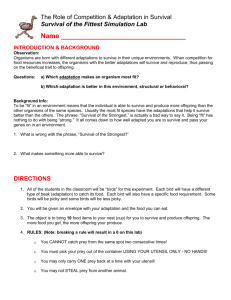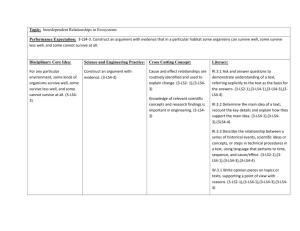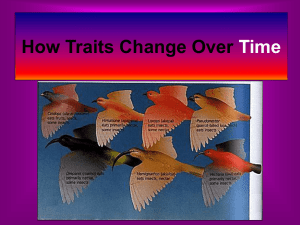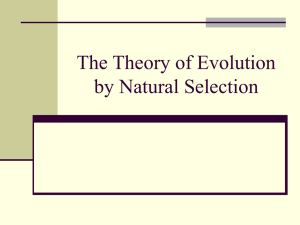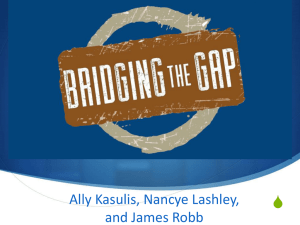Evolution Review
advertisement
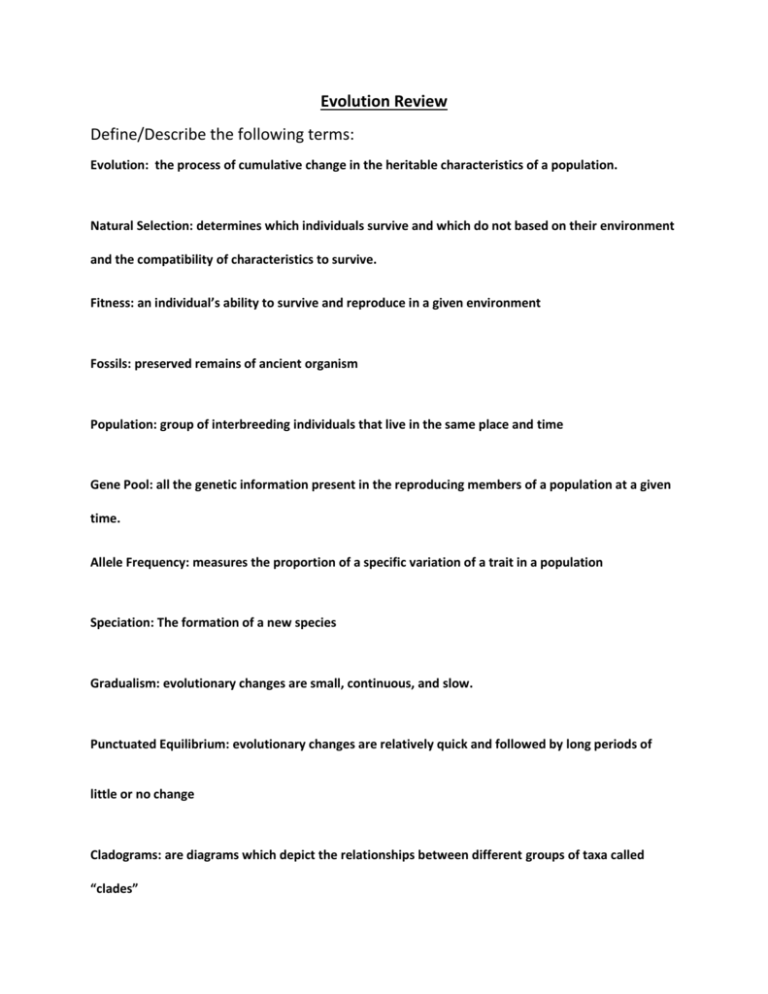
Evolution Review Define/Describe the following terms: Evolution: the process of cumulative change in the heritable characteristics of a population. Natural Selection: determines which individuals survive and which do not based on their environment and the compatibility of characteristics to survive. Fitness: an individual’s ability to survive and reproduce in a given environment Fossils: preserved remains of ancient organism Population: group of interbreeding individuals that live in the same place and time Gene Pool: all the genetic information present in the reproducing members of a population at a given time. Allele Frequency: measures the proportion of a specific variation of a trait in a population Speciation: The formation of a new species Gradualism: evolutionary changes are small, continuous, and slow. Punctuated Equilibrium: evolutionary changes are relatively quick and followed by long periods of little or no change Cladograms: are diagrams which depict the relationships between different groups of taxa called “clades” Outline the process of evolution with regards to natural selection • Begins when an overproduction of offspring occurs in a population (group of interbreeding individuals that live in the same place and time) • Most organisms produce far more offspring than could survive in an environment • Creates competition for resources (food, water, spaced, etc.) in populations which leads to the struggle for survival • Competition leads to adaptive behaviors/characteristics to gain/use more resources. • Adaptations can lead to variation within species and populations • Variations can provide individuals with advantage or disadvantage for survival (natural selection) • These advantages can lead to some individuals likelihood to survive and reproduce, which may ultimately lead to the formation of a new species What causes variety in the offspring of populations? • Mutations in DNA can lead to harmful or beneficial changes in organisms phenotype • • In Each generation only a few genes mutate and most have little affect on phenotype Sexual reproduction is more powerful source of variation through meiosis and fertilization • Meiosis: Random distribution of chromosomes results in each egg and sperm having different combinations from others • Fertilization: Combination of different genes from sperm and egg cell and only one sperm cell can fertilize one egg cell. Leads to variation in offspring What is meant by the survival of the fittest? • Individuals with characteristics that are not well suited to their environment – those with low levels of fitness – either die or leave few offspring • Individuals that are better suited to their environment – adaptations that enable fitness – survive and reproduce most successfully Outline the process of natural selection • Individuals w/in population overproduce offspring, which have natural variation due to genetic differences • Individuals with poorly adapted characteristics are less successful at gathering resources and have lower chance of survival • Individuals with well adapted characteristics are more successful at gathering resources and have a higher chance of survival • Individuals that survive have a better chance at reproducing and passing on their genetic traits • Over many generations the accumulations of genetic characteristics in a population results in evolution Describe what happens in gene pools when evolution occurs and why. • Gene pools are relatively stable over time, however, when changes occur, evolution is seen • New combinations of alleles lead to new phenotypes, that can then be selected for or against by the environment • Alleles that are advantageous to a populations survival will be passed on and have a higher frequency in later generations • Alleles that are disadvantageous will not be passes on and have a lower frequency in later generations • Immigrations and emigrations will also have an effect on allele frequencies • For whatever reason, when a gene pool in modified, some degree of evolution has occurred. Compare and contrast the ideas of gradualism and punctuated equilibrium. • Gradualism: changes are small, continuous, and slow • Supporters argue that the fossil record shows a succession of small changes in phenotypes of species indicating the process of speciation is a steady, constant process with transitional stages between major changes. • These adaptations occur over millions of years • Punctuated Equilibrium: changes are relatively quick and followed by long periods of little or no change • Speciation happens quickly, in a response to the environment, i.e. a volcanic eruption that destroys some species. • Organisms then adapt, exploiting new niches made available. The rest of the time, species live for millions of years with little or no change • Create a Cladogram for the following organisms and features: Organisms: Shark, Fish, Frogs, Crocodiles, Birds, Rodents, Primates Features: Vertebrate, Bony Skeleton, Four limbs, Amniotic Egg, Eggs w/shell, Feathers, Hair, Opposable Thumbs. The simplified cladogram of vertebrata is now shown with synapomorphies indicated. What organisms have bony ribs and shoulder girdles? Ray-finned fish, Lungfish, Amphibians, and Land Vertebrates What is the oldest creature in this cladogram? They youngest? Lampreys are the oldest, Land Vertebrates the youngest What feature is shared by amphibians and land vertebrates? Fingers and Toes What feature did the common ancestor of lungfish and lampreys have? Vertebrae What creature is most closely related to land vertebrates? Lampreys? Amphibians to land vertebrates and Sharks to lampreys Explain why the following examples are evidence of evolution. Fossil Record • indicates that life on earth is constantly changing and these changes occur over long periods of time (hundreds of thousands or millions of years) • Fossil - preserved remains of ancient organism. • Support the idea that life existed on earth over 500 million years ago Artificial Selection changes over time in domesticated animals or plants that are chosen by breeders Homologous Structures • Homologous structures: Structures that are similar in form but may have different functions, found in different species • Indicates a common ancestor • Vestigial Structures • Vestigial organs • Organs of many animals are so reduced in size that they are just vestiges, or traces, of homologous organs in other species • These do not affect an organism’s ability to survive and reproduce Embryonic Similarities: • Early stages, or embryos, of animals with a backbone are very similar • Same groups of embryonic cells develop in the same order and pattern to produce the tissues and organs of all vertebrates

